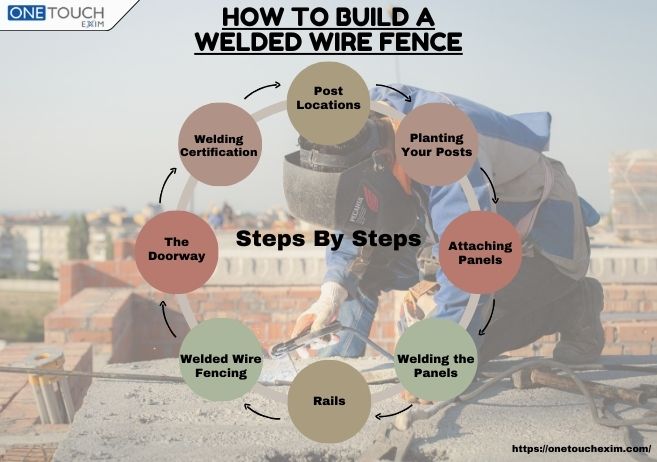Welded wire fencing is a versatile and durable solution for various purposes, such as enclosing gardens, protecting livestock, or creating boundaries. This type of fence is made from interwoven steel wires that are welded together, providing a strong and sturdy barrier. Building a welded wire fence isn’t very difficult, but be sure you do it right the first time, because mending it can be practically impossible. Before you begin, make sure you understand each step of how to build a welded wire fence, as well as what you will need.
Supply List Of How to Install Welded Wire Fence on Wood Posts
Installing a welded wire fence on wood posts is a cost-effective and durable solution. Here is a supply list and a step-by-step guide to help you install your welded wire fence on wood posts.
- Deck screws
- Concrete gravel
- Gate hinges and latches
- L-brackets
- String stakes
- Level
- Tape measure
- Post hole digger
- Stainless Steel Drill
- Circular saw
- 4×4 Posts
- 2×4 lumber
Step 1: Post Locations
Measure and stake where you want your corner posts to be. Once each post is staked out, double-check your measurements to ensure they are at right angles to one other. Tie a string between your corner posts to get a better idea of where your fence will run.
Measure where you want any additional posts between the corners. The average spacing between posts is 7 to 8 feet, although they should not be more than 10 feet apart. Mark each of these locations with stakes along the string line. Make sure the area designated for the gate is marked out.
Step 2 : Planting your posts
- Use a posthole digger or a two-person auger to dig holes. You might rent an auger to dig the post holes quickly. If using an auger, stay away from any places marked by the utility provider. Dig by hand if a hole needs to be located within 18 to 24 inches of a marked utility.
- Dig 8-inch diameter holes that are around 1/3 as deep as the posts’ height, plus about 6 inches for gravel.
- In colder climates, dig below the frost line to avoid heaving. You can check the frost line online or contact the building office in your community. As the temperature drops, if you don’t dig down far enough below the frost line, the posts will heave out of the earth.
Step 3: Attaching the Welded Wire Panels
Unroll the welded wire panels and attach them to the posts using wire clips. Make sure the panels are level and secure.
Step 4: Welding the Panels
Using a flux core wire or ER309L solid welding wire and a welding machine, weld the joints between the wire panels and posts. This will ensure the fence is strong and stable.
Step 5: Rails
For the top and bottom rails, cut 1×4 boards to the appropriate size. If your landscape is uneven, screw your bottom rail in place as close to the ground as possible while remaining level. Measure the distance between the center of the board and the desired height of your fence’s top. This is the level where you should place your top rail, regardless of where it sits on the left and right posts. Make a cut and fasten the upper rail firmly.
Step 6: Welded Wire Fencing
Beginning at a corner post, unroll several feet of welded wire. Check that the fencing is fully level and staple it all the way down to the end. Now it’s time to weld the fence posts together. Begin by attaching the vertical wires to the horizontal bottom wire using the ER309L solid welding wire. Ensure the wires are evenly spaced and aligned correctly. Use your welding machine and follow proper safety precautions while welding. Continue all the way around.
Step 7: The doorway
Not all fences have gates, but if you do, I recommend constructing them last. You should already have the gate posts placed. The site is typically between two fence posts or a fence post and a house or other significant structure.
To calculate the width of the gate, measure between the support posts and subtract around 2 inches. This allows ample space for the hinges and lock. There won’t be enough space for the gate to swing if you make it the exact distance between two posts.
Attach the hinges to the gate first, then the post. Verify that the hinges are positioned squarely and level. If the hinges are even slightly out of alignment, they will twist as you open and close the gate. I recommend purchasing a gate with the hinges already installed. It greatly simplifies installation. Once the gate is up, attach the handle or latch.
Screw the hinges to the post. The type is determined by the kind of post you are using. Metal for metal posts, wood for wood, and concrete for concrete. It’s all extremely self-explanatory. The screw I suggest is roughly three inches long. If the screws are too short the weight of the gate could pull them out.
Step 8: Welding Certification
If you’re undertaking a professional project or working on a large-scale fence, obtaining a welding certification can demonstrate your competency and adherence to industry standards.
Conclusion
A welded wire fence is an excellent way to secure your property and keep animals out, and pets in while still allowing view through it. If you are doing the task on your own, you are in luck. Welded wire fence installation is not too difficult. Although you can build a wire-welded fence on your own, I recommend bringing a friend or two, particularly if the fence is tall. Selecting the material for the fence posts is the first step. Welded wire can be used with concrete, metal, or wood posts.
